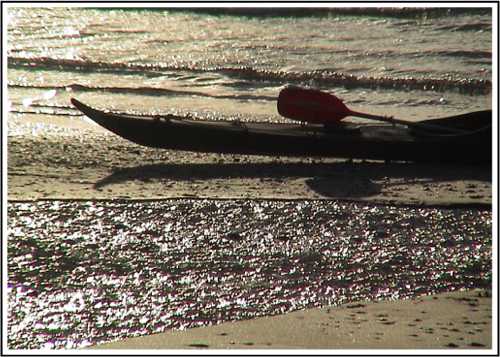Ideally, healthy humans have ... a gift for risk-taking ... the strength to learn from experience ...
... and the ability to risk enchantment and to feel a sense of awe.
Collier & Longmore, Oxford Handbook of Clinical Specialities
Sea kayaking overview
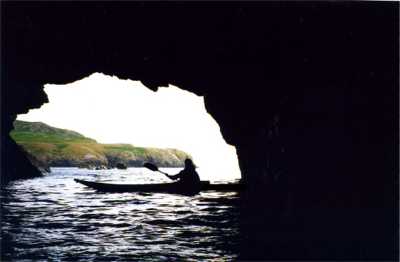
If you love rockpools and cliff walks, probably you will love sea kayaking. A kayak is easy to transport, silent and needs no special courage, strength or reflexes. Leave the beach behind and see what's round the headland.
Fridtjof Nansen said the classic sea kayak is "far and away the best one-man boat in existence". A polar explorer and Nobel laureate, he knew what he was talking about.
What makes a sea kayak so great? Well, a sea kayak is:
- fast. A classic sea kayak can easily go faster and further than a walker, fast enough to go against a current.
- quick to get ready. Put it on your car, drive to a beautiful place, launch and go.
- light. Just carry it down the beach, or hook it up in the roof of your garage, or even take it in the elevator up to a city-centre apartment.
- slim. A sea kayak will take you through a reed bed, into a cave, up a narrow river, into a shallow estuary, or between a tide race and the cliffs. Kayakers like to go where there aren't any yachts or powerboats.
- beautiful. More than one sculptor has kept a Greenland kayak for inspiration in the studio.
- affordable. There's an initial outlay, sure, but all kayaking gear is durable and long-lasting. A good kayak can take thirty or forty years of hard use, and you can make a tough and lovely sea kayak for next to nothing.
- a great way to see wildlife. A sea kayak is low, fast and silent so you see nature up close. No flapping sails, squeaking oars or engine noise.
- .... but most of all, a sea kayak is seaworthy. A trained sea kayaker in the right kayak can cope with waves, surf and wind from the Arctic to the tropics. When you're experienced, you can do things that would make a sailor or powerboater's jaw drop.
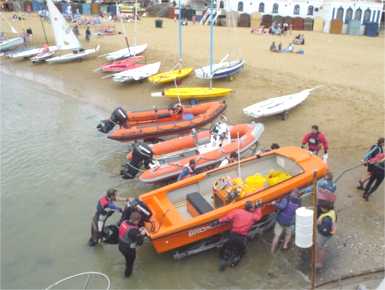
Because a kayak is seaworthy, a kayaker can be independent. Unlike a dinghy sailing club, a group of kayakers can go to a new venue every weekend, and never needs a rescue boat (unlike this dinghy club, which needs three rescue boats to be safe).
Your own muscles provide the power, and the gentle exercise keeps you healthy. On a cold day, the exercise and the fact of being sealed into your kayak are enough to keep you warm, and on a hot day you can just roll in to cool off.
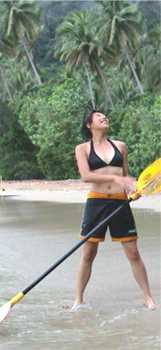
Anybody can walk or kayak a few miles. A fit person can easily walk ten miles (16 km) or paddle fifteen miles in a classic sea kayak. If you are really on a mission, you can walk twenty-five miles or kayak forty miles (65 km) although you may not be much use at work the next day.
Hairy-chested kayaking epics do happen, but only if you want them to. If kayaking books are often about endurance, terror and deep trouble it’s because “broke my paddle off Tierra del Fuego and had to eat my own shoes” is more interesting than “saw some terns and a seal, went round an island, surfed over a reef, got my nose slightly sunburnt, covered a good distance, feel good about it”.
Nearly half of sea kayakers are women, and kayak manufacturers now recognize this. In 2009 Freya Hoffmeister kayaked 9000 miles round Australia. See her site at Qajaq Underground.
Solo sea kayakers have paddled round Newfoundland, Britain, Ireland, Iceland, New Zealand, Japan, the Mediterranean and Australia. A teenage girl from Scotland has kayaked round Cape Horn. Ordinary sea kayaks have made solo open-water crossings of 50 and 60 nautical miles in 24 hours.
You can go sea kayaking in a general-purpose kayak. If you go out only on warm seas under a hot sun, you may prefer a sit-on-top kayak but we think a classic sea kayak is best. They are more expensive but they last a long time, and they're fast enough to go against a current.
Compared with other sports
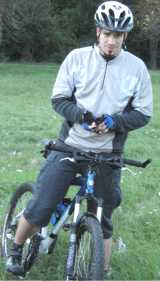 Sea kayaking is like walking - you can stroll around a city centre park, or you can hike to the top of Mount Whitney.
Sea kayaking is like walking - you can stroll around a city centre park, or you can hike to the top of Mount Whitney.
Sea kayaking has something in common with mountaineering and mountain-biking - they're all adventurous sports that you can do at any level that suits you, from easy to extreme. All of them bring you in touch with nature in a way which teaches a certain respect, and they can all easily be done in a new location.
Done right, sea kayaking is perhaps the safest adventure sport. It's a lot safer than mountain-biking, horse riding, scuba diving, paragliding or even hill-walking.
When Derek Hutchinson wrote Sea Canoeing in 1974, he was able to say "Britain... leads the world in the sport of sea kayaking" but by 1990 the sport was exploding in the USA and Canada, especially in the Pacific Northwest. When Mr H wrote The Complete Book of Sea Kayaking in 1995 he nearly laughed out loud on reading his earlier comment because by then the USA and Canada had more ocean paddlers than any other country in the world.
That growth has continued, and sea kayak tourism has become a significant part of the economy of many coastal communities in Washington, British Columbia, Alaska and other places. Sea kayaking has also taken off in quite a big way in New Zealand and Germany, and is presently doing so in France, Spain and other European countries.
In Britain, the profile of sea kayaking is not much higher now than it was fifty years ago. Which is strange because conditions on the west coast of Scotland are very similar to those in the Pacific Northwest (wildlife, climate and weather, a sheltering chain of islands, inter-island ferries, supplies, cultural history, and a nearby continent full of people increasingly keen to try wilderness kayaking). And there's equally great coastline in Devon, Cornwall, Pembrokeshire and elsewhere.
Not that a lack of mass tourism is entirely a bad thing... in 2001 your editor spent five months on Skye and Mull with two sea kayaks on his vehicle and at least one on the water most days. He saw lots of seals, porpoises, eagles, terns, gannets, skua, shearwaters, guillemots (murres), razorbills, puffins, eider and shelduck, some great northern divers (common loons, not so common in Britain), a pod of orca, a few dolphins and otters but scarcely another sea kayaker the whole time. Two sea kayakers seeing each other in the distance would usually get together for a chat.
Learn to roll
Rolling a kayak is a basic skill, and it's easy to learn if you have a good instructor. You can even teach yourself, using the instructions on Kayarchy.
When you can recover from a capsize in a few seconds, and carry out a deep water rescue of another kayak, your kayaking skills and experience can really take off.
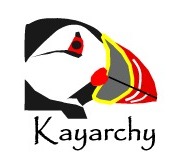
About Kayarchy
Kayarchy's principles
Kayarchy is based on three principles*:
• Simple equipment and simple technique are enough.
• If sea kayaking turns out to be your thing, you need never stop learning.
• Sea kayaking makes you identify with the marine environment, which needs all the friends it can get.
*But in the words of Groucho Marx, "These are my principles. If you don't like them, I have others."
Created and maintained by...
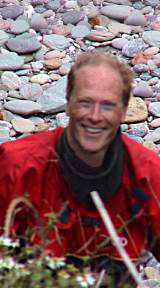
The Kayarchy website is written and illustrated by Nicholas, who has been crazy about small boats for as long as anybody can remember and started kayaking at age 10. He would like to see more people sea kayaking, especially in coastal communities.
Contributors
Everybody has their own vision of sea kayaking. American, Canadian, British, French and New Zealand kayakers have helped give Kayarchy a broad perspective. Thank you to everybody. We would particularly like to thank the following, in alphabetical order by first name:
Alan Byde, now living in New Zealand, for the black-and-white technique illustrations, textual suggestions, and information about curragh building. Alan wrote classic 1960s-70s kayaking books including Living Canoeing, Canoe Building in Glass Reinforced Plastic, and Canoe Design & Construction.
Alex Ferguson of New Zealand. Kayaker and designer of plywood kayaks. Although he denies it himself, Sandy has been described to us as "one of NZ's top kayaking gurus".
Howard Oakley, Head of Survival & Thermal Medicine at the Royal Navy's Institute of Naval Medicine. Author of many published papers on survival at sea plus other medical matters and genetic computer programming. A sea kayaker himself, he turned around your editor's understanding of the hazards of cold water and made textual suggestions about cold shock, swimming failure and hypothermia.
Murty Campbell of Stornoway Canoe Club, Scotland, for many photos of kayaking in the Outer Hebrides. See more, including trips to St Kilda, on his flickr page.
Orsolya, kayaker, sailor and jewellery maker, for photos of kayaking and wildlife.
Paul Caffyn of New Zealand, sea kayaking circumnavigator, for textual suggestions and a bibliography of books about kayaking and the sea. A writer himself, he recounts his experiences in Obscured By Waves, Cresting The Restless Waves, Dark Side Of The Wave and The Dreamtime Voyage.
Richard Best, England, builder of traditional kayaks and baidarkas, for the photos of Greenland and the opportunity to experience traditional clothing and equipment.
Several images are courtesy of the US Coast Guard Department of Boating Safety - yellow kayaker, red canoe, red lifejackets, yellow kayak.
Want to buy us a coffee?
Kayarchy relies on donations to pay for hosting and development.
If you want to buy us a coffee via PayPal, that'll be great - just click the "Donate" button and choose an amount in $ USD.
(If you'd rather make a donation in £ GBP, you can do that on the UK edition of Kayarchy here.)
Get in touch
For everything about Kayarchy, please send an e-mail to:
![]() co .uk
co .uk
Comments, photos and illustrated articles about any aspect of sea kayaking, kayak building, marine wildlife and the coastal environment are very welcome (but please no obvious adverts for your product or service).
If you're sending an attachment, please put your message in one mail and attach the photo/document to another one.
Metric measurements
Statute mile = 1.61 kilometers.
Yard = 3 feet = .914 meters.
Foot = 30.5 centimeters.
Inch = 2.54 centimeters.
| Millimeters | Nearest fractions of an inch (approximate) | Fractions of an inch | Nearest millimeters (approximate) | |||
| 0.5 mm | 1/64" | 1/64" | 0.4 mm | |||
| 1 mm | 3/64" | 1/32" | 0.8 mm | |||
| 2 mm | 5/64" | 1/16" | 1.6 mm | |||
| 3 mm | 1/8" | 1/8" | 3.2 mm | |||
| 4 mm | 5/32" | |||||
| 5 mm | 3/16" | |||||
| 6 mm | 1/4" | 1/4" | 6.3 mm | |||
| 7 mm | 9/32" | |||||
| 8 mm | 5/16" | |||||
| 9 mm | 11/32" | 3/8" | 9.5 mm | |||
| 10 mm | 25/64" | |||||
| 11 mm | 7/16" | |||||
| 12 mm | 15/32" | |||||
| 13 mm | 1/2" | 1/2" | 12.7 mm |
A nautical mile, which is a measurement used by seafarers everywhere, is 1.15 land miles. See The Nautical Mile.
Fathom = 6 feet = 1.83 meters.
Pound = 0.453 kilograms.
Gallon = 3.785 litres (US gallon), 4.546 litres (Imperial gallon)
Associated websites
Nicholas doesn't spend ALL his time in a kayak:
Teaching English as a Foreign Language...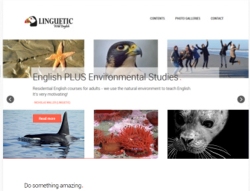 |
Environmental English...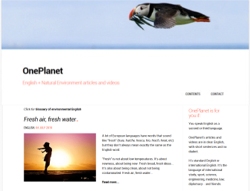 |
The UK and Europe edition of Kayarchy...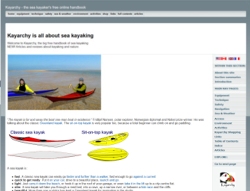
|
...and translating from French to English |
Legal notice & privacy policy
The quickest way to take up kayaking is to get face-to-face training from an experienced coach, probably one with a senior coaching qualification. When you have the technical skills, join local kayakers to make trips. Start in sheltered waters and then make increasingly demanding expeditions.
The Kayarchy website was put together for fun, to give you some idea what to expect if you go sea kayaking. It is up to you to get suitable training from qualified instructors, and to obtain and check all information about local conditions, local regulations and kayaking equipment. Before using any product mentioned on this site you should read the manufacturer's data sheet.
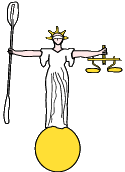 |
Disclaimer It is also a condition of use that if you do make a claim and the courts decide that Nicholas or any Kayarchy contributor is liable, their total liability shall be no more than £1 (one pound sterling) for compensation to yourself or any third party; and no more than £1 for your legal costs and expenses or those of any third party. Any claims or disputes shall be governed by the substantive law and legal procedure of England, and only the courts of England & Wales shall have jurisdiction. |
 |
Intellectual property The text, photos, graphics and design are protected by copyright and may not be reproduced or distributed without written permission. Except in the case of photos contributed by Murty, Orsolya, Richard and others, and the booklist contributed by Paul Caffyn, the copyright holder is Nicholas. "Kayarchy" is a trademark and may not be used without written permission. Your privacy |
Go to next page for:
• Contents of Equipment chapter
